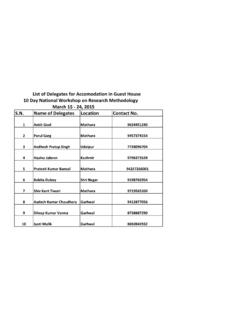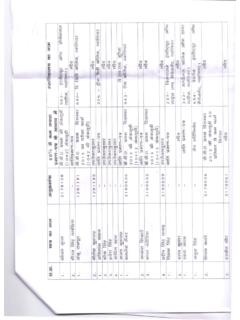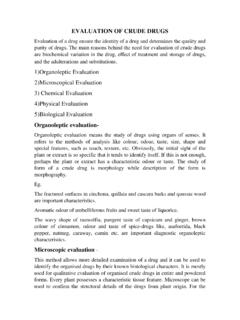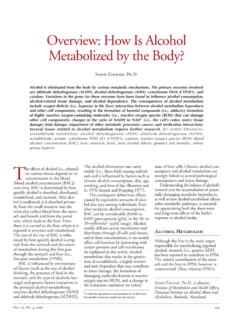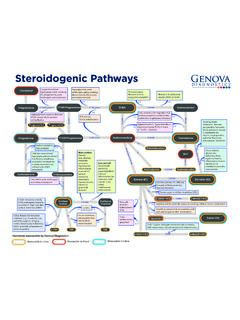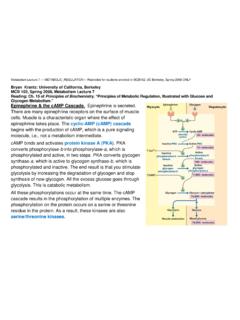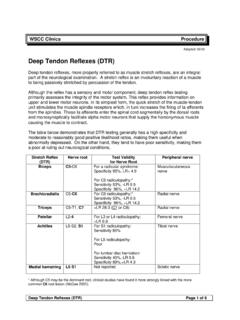Transcription of METABOLIC PATHWAYS - Jiwaji University
1 METABOLIC PATHWAYSCATABOLIC PATHWAYSAre involved in oxidative breakdown of larger are usually exergonicin natureANABOLIC PATHWAYSAre involved in the synthesis of are usually endergonicin OF PATHWAYS are mostly METABOLIC pathway has a committed first METABOLIC PATHWAYS are PATHWAYS in eukaryotic cells occur in specific cellular comes from a merger of two Greek words: Glykys= sweet Lysis= breakdown/ splittingIt is also known as Embden-Meyerhof-Parnaspathway or EMP GLYCOLYSIS is the sequence of 10 enzyme-catalyzed reactions that converts glucose into pyruvate with simultaneous production on of ATP. In this oxidative process, 1mol of glucose is partially oxidisedto 2 moles of pyruvate.
2 This major pathway of glucose metabolism occurs in the cytosolof all cell. This unique pathway occurs aerobically as well as anaerobically& doesn t involve molecular oxygen. It also includes formation of Lactate from Pyruvate. The glycolytic sequence of reactions differ from species to species only in the mechanism of its regulation & in the subsequent METABOLIC fate of the pyruvate formed. In aerobic organisms, glycolysis is the prelude to Citric acid cycle and ETC. Glycolysis is the central pathway for Glucose matrix & cell wall , Starch, SucrosePyruvateRibose-5-phosphateOxidati on viapentose phosphatepathwaySynthesis ofstructural polymersstorageOxidationvia glycolysisMajor PATHWAYS ofglucose PHASES OF GLYCOLYSIS Glycolysis leads to breakdown of 6-C glucose into two molecules of 3-C pyruvate with the enzyme catalyzed reactions being bifurcated or categorized into 2 1-preparatory 2-payoff PHASE It consists of the 1st5 steps of glycolysis in which the glucose is enzymatically phosphorylated by ATP to yield Fructose-1,6-biphosphate.
3 This fructuse-1,6-biphosphate is then split in half to yield 2 molecules of 3-carbon containing Glyceraldehyde-3-phosphate/ dihyroxyacteonephosphate. Thus the first phase results in cleavage of the hexosechain. This cleavage requires an investment of 2 ATP molecules to activate the glucose mole and prepare it for its cleavage into 3-carbon PHASE This phase constitutes the last 5 reactions of Glycolysis. This phase marks the release of ATP molecules during conversion of Glyceraldehyde-3-phosphtae to 2 moles of Pyruvate. Here 4 moles of ADP are phosphorylated to ATP. Although 4 moles of ATP are formed, the net result is only 2 moles of ATP per mole of Glucose oxidized, since 2 moles of ATP are utilized in Phase EXPLAINATION OF GLYCOLYSISSTEP 1:PHOSPHORYLATION Glucose is phosphorylated by ATP to form sugar phosphate.
4 This is an irreversible reaction & is catalyzed by hexokinase. Thus the reaction can be represented as follows:GlucoseGlucose-6-phosphateHexoki naseATPADPSTEP 2:ISOMERIZATION It is a reversible rearrangement of chemical structure of carbonyl oxygen from C1 to C2, forming a Ketosefrom the Aldose. Thus, isomerizationof the aldoseGlucose6-phosphate gives the ketose, 3:PHOPHORYLATION Here the Fructose-6-phosphateis phosphorylated by ATP to fructose-1,6-bisphosphate. This is an irreversible reactionand is catalyzed by ,6-bisphosphateATPADPP hosphofructokinaseSTEP 4:BREAKDOWN This six carbon sugar is cleaved to produce two 3-C molecules: glyceradldehyde-3-phosphate (GAP) & dihydroxyacetone phosphate(DHAP).
5 This reaction is catalyzed by ,6-bisphosphateGlyceraldehyde-3-phosphat eDihydroxyacetone phosphateTriose phosphateisomeraseAldolaseSTEP 5:ISOMERIZATION Dihydroxyacetone phosphate is oxidized to form Glyceraldehyde-3-phosphate. This reaction is catalyzed by triosephosphate phosphateTriose phosphate isomerase22 STEP 6 2 molecules of Glyceraldehyde-3-phosphate are oxidized. Glyceraldehyde-3-phosphate dehydrogenasecatalyzes the conversion of Glyceraldehyde3-phosphate into 1, acidCarboxylic acidOrtho-phosphateAcyl-phosphate productJoining)Resultant reactionGlyceraldehyde-3-phosphate1,3-bi sphosphoglycerateGlyceraldehyde-3-phosph atedehydrogenase2 NAD + 2Pi2 NADH + 2H 22 STEP 7 The transfer of high-energy phosphate group that was generated earlier to ADP, form ATP.
6 This phosphorylation addition of phosphate to ADP to give ATP is termed as substrate level phosphorylationas the phosphate donor is the substrate 1,3-bisphosphoglycerate (1,3-BPG). The product of this reaction is 2 molecules of ,3-bisphosphoglycerate3-phosphoglycerate Phosphoglyceratekinase2 ADP2 ATPFIRST SUBSTRATE LEVELPHOSPHORYLATION22 STEP 8 The remaining phosphate-ester linkage in 3-phosphoglycerate, is moved from carbon 3 to carbon 2 ,because of relatively low free energy of hydrolysis, to form2-phosphoglycerate(2-PG).3-phosphogl ycerate2-phosphoglyceratePhosphoglycerat e mutase22 STEP 9: DEHYDRATION OF 2-PG This is the second reaction in glycolysis where a high-energy phosphate compound is formed.
7 The 2-phosphoglycerate is dehydrated by the action ofenolase to phosphoenolpyruvate(PEP). This compound is the phosphate ester of the enol tautomer of pyruvate. This is a reversible OEnolase22 STEP 10:TRANSFER OF PHOSPHATE FROM PEP to ADP This last step is the irreversible transfer of high energy phosphorylgroup from phosphoenolpuruvateto ADP. This reaction is catalyzed by pyruvate kinase. This is the 2ndsubstrate level phosphorylation reaction in glycolysis which yields ATP. This is a non-oxidative phosphorylation 22 Pyruvate kinaseSECOND SUBSTRATE LEVEL PHOSPHORYLATION2 ADP2 ATPOVERALL BALANCE SHEET OF GLYCOLYSIS Each molecule of glucose gives 2 molecules of Glyceraldehyde-3-phosphate.
8 Therefore , the total input of all 10 reactions can be summarized as:Glucose + 2 ATP+ 2Pi+ 2 NAD + 2H + 4 ADP2 Pyruvate+ 2H + 4 ATP+ 2H O+ 2 NADH+ 2 ADPOn cancelling the common terms from the above equation, we get the net equation for Glycolysis: Glucose+ 2Pi+ 2 ADP+ 2 NAD 2 Pyruvate+ 2 NADH+ 2 ATP+ 2H + 2H OTHUS THE SIMULTANEOUS REACTIONS INVOLVED IN GLYCOLYSIS ARE: Glucose is oxidized to Pyruvate NAD is reduced to NADH ADP is phosphorylated to ATP ENERGY YIELD IN GLYCOLYSIS:STEP ATPGAIN of ATP1 Glucose glucose-6-phosphate1-3 Fructose-6-phosphate fructose-1,6-biphosphate1-71,3-diphospho glycerate 3-phosphoglycerate-1x2=210 Phosphoenolpyruvate pyruvate -1x2=224 Net gain of ATP=4-2= 2


